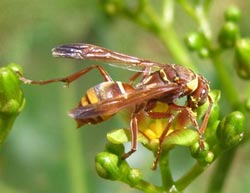Diversity and Abundance of Some Insect Fauna in Krau Wildlife Reserve Forest, Malaysia.

Copyright : C.C. tonrulkens http://www.flickr.com/photos/47108884@N07/4483279535<br>
This study was initiated due to the changes taking place to the natural habitat of insects due to logging and development. These activities pose a great threat to insect communities in the forest.
The study focused on Hymenoptera known as the most important group of insects in any terrestrial ecosystem. Bees, wasps and ants are some of the insects in this group. They are important pollinators of flowering plants as well as predators of many arthropods. As such, many of them can be classified as the key stone species in a particular ecosystem.
Preliminary observation showed that the Hymenopteran were quite diverse at the Krau Wildlife and Forest Reserve (KWFR), Pahang, geographically considered as a lowland dipterocarp forest, which is connected to the Malaysian National Park. The objective of this study was to determine the level of biodiversity, abundance and richness of Hymenoptera in Kuala Lompat, Krau Wildlife Forest Reserve and to study its relationship, if any, between changes in environmental gradient from forest fringes and deeper into the forest.
The findings of this study indicated that certain species of insects were found in abundance along the fringes of the forest where many species of flowering plants were found. However, closed and narrow areas deeper in the forest with many trees, shrubs and grass provided shelter for the insects from predators for example birds and therefore constituted a higher diversity of Hemiptera compared to those found at the forest fringes or along the river which is more open and exposed to predators.
In conclusion, the study area in KWFR forest, Kuala Lompat recorded 1236 specimens and 55 morphospecies of insects under order Orthoptera, Hemiptera and Diptera. For Orthoptera and Diptera, forest fringes recorded the highest abundance while for Hemiptera, the most abundant individuals were found in the interior of the forest. Orthoptera, Hemiptera and Diptera could be used as a bio indicator in Malaysian forest because their ease in identification process and well known taxonomic. This method is useful and should be used by ecologist in forest conservation program.
SITI KHAIRIYAH BINTI MOHD HATTA
sitikhairiyah@salam.uitm.edu.my
FAUZIAH BINTI HJ ISMAIL
fauziah@salam.uitm.edu.my
Universiti Teknologi MARA, Malaysia
Funding information
Excellence Fund, Research Management Institute, UiTM, Malaysia
Media Contact
All latest news from the category: Ecology, The Environment and Conservation
This complex theme deals primarily with interactions between organisms and the environmental factors that impact them, but to a greater extent between individual inanimate environmental factors.
innovations-report offers informative reports and articles on topics such as climate protection, landscape conservation, ecological systems, wildlife and nature parks and ecosystem efficiency and balance.
Newest articles

Innovative 3D printed scaffolds offer new hope for bone healing
Researchers at the Institute for Bioengineering of Catalonia have developed novel 3D printed PLA-CaP scaffolds that promote blood vessel formation, ensuring better healing and regeneration of bone tissue. Bone is…

The surprising role of gut infection in Alzheimer’s disease
ASU- and Banner Alzheimer’s Institute-led study implicates link between a common virus and the disease, which travels from the gut to the brain and may be a target for antiviral…

Molecular gardening: New enzymes discovered for protein modification pruning
How deubiquitinases USP53 and USP54 cleave long polyubiquitin chains and how the former is linked to liver disease in children. Deubiquitinases (DUBs) are enzymes used by cells to trim protein…



